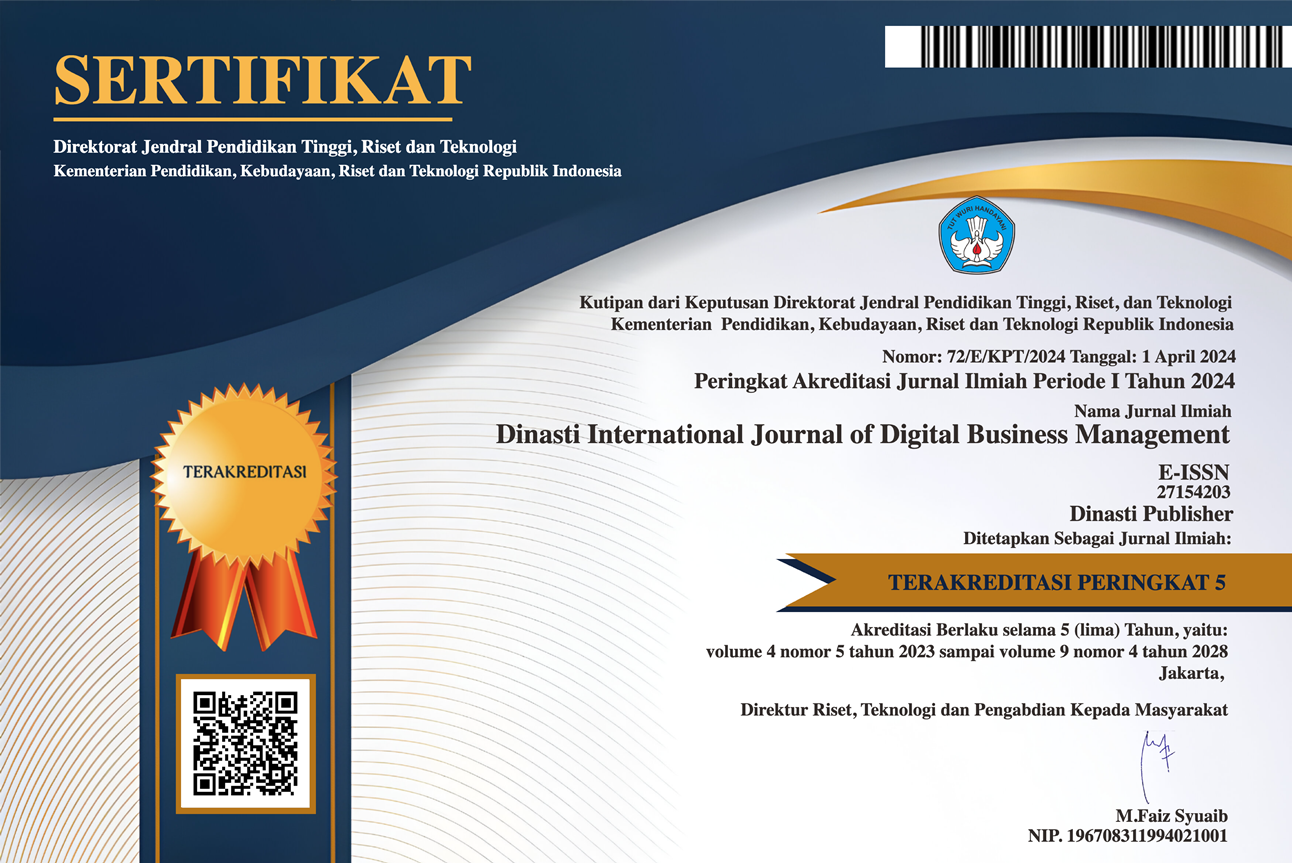The Influence of Management Information System Integration and Personnel Data Management on the Effectiveness of Leadership Decision-Making at Disinfolahtaau
DOI:
https://doi.org/10.38035/dijdbm.v6i3.4533Keywords:
Leadership, data management, decision-making, DisinfolahtaauAbstract
This study aims to analyze the impact of the integration of personnel management information systems and data management on the effectiveness of decision-making by leaders at Disinfolahtaau. A quantitative research approach was employed, with data collected from 51 respondents using structured questionnaires. The results of the validity and reliability tests showed that all research instruments were valid and reliable. The normality test indicated that the data were normally distributed, while multicollinearity and heteroscedasticity tests confirmed the absence of any violations in the regression model. The findings from multiple linear regression analysis revealed that both the integration of management information systems (X1) and personnel data management (X2) significantly and positively affect decision-making effectiveness (Y). The regression equation Y=1.256+0.412X1+0.530X2 indicates that personnel data management has a stronger influence. The coefficient of determination (R²) of 0.82 shows that 82% of decision-making effectiveness is explained by these variables. The simultaneous F-test confirmed the significant combined influence of X1 and X2. These findings emphasize the importance of integrating technology and optimizing data management to enhance organizational decision-making. Future research should explore other contributing factors such as organizational culture and leadership styles.
References
Armah, S., & Firdaus, R. (2024). Konsep Dan Penerapan Sistem Informasi Manajemen. Jurnal Inovasi Manajemen, Kewirausahaan, Bisnis Dan Digital, 1(3), 50–56. https://doi.org/10.61132/jimakebidi.v1i3.192
Ghozali, I. (2016). Aplikasi analisis multivariete dengan program IBM SPSS 23.
Hasibuan, M. S. P. (2017). Manajemen Sumber Daya Manusia. Bumi Aksara. https://books.google.co.id/books?id=ZQk0tAEACAAJ
Hendrianto, D. E. (2020). Pembuatan Sistem Informasi Perpustakaan Berbasis Website Pada Sekolah Menegah Pertama Negeri 1 Donorojo Kabupaten Pacitan. Indonesia Journal on Networking and Security, 3(4), 57–64.
Ilham, B. A. (2022). Sistem Informasi Manajemen (Sim) Sebagai Sarana Pencapaian E-Government. Jurnal Stie Semarang, 14(2), 184–195.
Rivai, V. (2016). Manajemen sumber daya manusia untuk perusahaan.
Salbiah, & Nasution, M. I. P. N. (2024). ANALISIS PENGOLAHAN DATA DALAM SISTEM INFORMASI MANAJEMEN. Jurnal Ilmiah Ekonomi Dan Manajemen, 1(1), 01–12. https://ejournal.upi.edu/index.php/manajerial/article/view/16450
Sholihin, P. M., & Ratmono, D. (2021). Analisis SEM-PLS dengan WarpPLS 7.0 untuk Hubungan Nonlinier dalam Penelitian Sosial dan Bisnis. Penerbit Andi. https://books.google.co.id/books?id=NbMWEAAAQBAJ
Sujawerni, V. W. (2015). Metodologi penelitian bisnis & ekonomi. In Yogyakarta: Graha Ilmu.
Sutrisno, E. (2021). Manajemen Sumber Daya Manusia. Kencana. https://books.google.co.id/books?id=OhZNDwAAQBAJ
Wahyuni, D., Fadillah Rezeki, S., & Manajemen Informatika dan Komputer Imelda, A. (2019). Jurnal Multimedia dan Teknologi Informasi Sistem Informasi E-Learning AMIK Imelda Untuk Meningkatkan Mutu Pembelajaran. 01.
Widarjono, A. (2021). Analisis multivariat terapan dengan program SPSS, AMOS, dan SMARTPLS. UPP STIM Ykpn.
Yosepha, S. Y., Zulfitra, Z., Sahroni, S., & Hakim, L. (2024). Determinants of stock return in 10 biggest market capitalization on the Indonesian stock exchange. JPPI (Jurnal Penelitian Pendidikan Indonesia), 10(2), 790–798. https://doi.org/DOI: https://doi.org/10.29210/020244150 Contents
Zulkifli, T., Arifin, A., & Rahmisyari, R. (2024). Pengaruh Sistem Informasi Sumber Daya Manusia Terhadap Kinerja Pegawai, Evaluasi Kerja Pegawai Sebagai Variabel Intervening Pada Lingkup Satuan Kerja Perangkat Daerah Kabupaten Tojo Una – Una. Lokawati?: Jurnal Penelitian Manajemen Dan Inovasi Riset, 2(4), 216–228. https://doi.org/10.61132/lokawati.v2i4.1030
Downloads
Published
Issue
Section
License
Copyright (c) 2025 Windi Iswarini

This work is licensed under a Creative Commons Attribution 4.0 International License.
Authors who publish their manuscripts in this journal agree to the following conditions:
- The copyright on each article belongs to the author(s).
- The author acknowledges that the Dinasti International Journal of Digital Business Management (DIJDBM) has the right to be the first to publish with a Creative Commons Attribution 4.0 International license (Attribution 4.0 International (CC BY 4.0).
- Authors can submit articles separately, arrange for the non-exclusive distribution of manuscripts that have been published in this journal into other versions (e.g., sent to the author's institutional repository, publication into books, etc.), by acknowledging that the manuscript has been published for the first time in the Dinasti International Journal of Digital Business Management (DIJDBM).















































